Using Second Life, Hu Opens Up a New World of Communication to her Students
Students in Yifeng Hu’s Introduction to Communication Studies and New Media and Health Communication classes are exploring how communication takes place within virtual worlds.


Students in Yifeng Hu’s Introduction to Communication Studies class had a guest lecturer in early March. Karen Cooper ’82, a doctoral candidate in instructional technology at the University of Central Florida, spoke on “How Technology is Changing the Way We Learn.” Cooper wasn’t on TCNJ’s campus though—she was at home in Florida—and some of Hu’s students were not even in a physical classroom—they were sitting in their dorms wearing pajamas and slippers. Cooper’s lecture took place in Second Life (SL), an online, 3D, virtual world that Hu, an assistant professor of communication studies, uses extensively in her classes.
In SL, users design their own avatars and interact with other “residents” inside a user-created virtual realm. Although SL looks like a video game—and many people use it only for recreational purposes—a growing number of educators are incorporating it into their pedagogy. While attending a new media conference last summer, Hu witnessed how SL is being used to enhance students’ learning experiences. She quickly got herself up to speed on the technology and incorporated it into her Intro class as well as her New Media and Health Communication class.
With funding from an Office of Information Technology mini-grant, Hu rented an island within SL. She also used part of the grant money to hire Richard DeFrancisco ’10, a computer science major and student worker in TCNJ’s Instructional Technologies Services office, to “build” a virtual campus on the island, where Hu’s classes meet. During these in-world lessons, students can attend class inside a virtual castle or even atop the platform that floats above the island (in SL, flying is as easy as pressing the “F” key on your keyboard). These virtual meeting spaces offer everything a real-world classroom would—for example, projector screens and video monitors that can be used by the instructor. But the in-world class sessions offer some distinct advantages, Hu explained.
“The interactive nature of Second Life really helps the students become more engaged in the learning process,” Hu said. During an in-world class session, students can continuously ask questions and make comments via SL’s live-chat feature. The students also use the chat feature to “reinforce and complement each other’s perspectives,” thus creating a more meaningful dialogue during classes, Hu said. (An added benefit of using the chat feature, Hu discovered, is that “shy” students are more willing to participate in class discussions.)
 Hu’s Intro class used SL to examine whether the real-life communications theories they were learning were applicable in a virtual world. For example, when learning about the spiral of silence theory of communication (which, to greatly summarize, states that a person is less likely to express an opinion if he or she is in the minority), some of Hu’s students attended an in-world campaign rally for Barack Obama. Once there, they researched what happened when they engaged the Obama supporters in discussions of the merits of John McCain’s platform. “Second Life offers students not only a safe environment in which to research and experience these theories, but also serves as a way to reinforce the students’ understanding of them,” Hu said.
Hu’s Intro class used SL to examine whether the real-life communications theories they were learning were applicable in a virtual world. For example, when learning about the spiral of silence theory of communication (which, to greatly summarize, states that a person is less likely to express an opinion if he or she is in the minority), some of Hu’s students attended an in-world campaign rally for Barack Obama. Once there, they researched what happened when they engaged the Obama supporters in discussions of the merits of John McCain’s platform. “Second Life offers students not only a safe environment in which to research and experience these theories, but also serves as a way to reinforce the students’ understanding of them,” Hu said.
Her New Media class explored how SL is helping to address some of today’s leading healthcare issues. The students toured an in-world virtual medical clinic and were shown proper breast self-examination techniques. Afterwards, they reported that the virtual demonstration “was more engaging than just reading a plain-text explanation of how to do it,” Hu said. Several students even reported feeling “empowered” by the experience. The class also explored how virtual worlds are being used to reinforce patients’ weight-loss programs, and to give insight into what schizophrenic hallucinations are like. “It’s important for the medical community, including people in health communications, to understand what these types of patients experience,” and Second Life allows them to do that, Hu said.
Since these are writing-intensive communications courses, Hu’s students must submit reflection papers after each in-world experience. There are also group projects for the students to complete, such as one that examined the motives for disabled people to use SL, and what benefits these users get from the application.
Hu admits there was a steep learning curve to get up and running with SL, as first she, then her students, had to familiarize themselves with navigating and communicating in world. But the feedback she has collected shows her students overwhelmingly enjoyed this type of learning experience.
“They love it,” Hu said. “They’ve said to me several times, ‘We should have class within Second Life all the time.’” Perhaps more importantly, she added, “When the learning process is more fun, it is also more engaging for the students.”
Posted on May 29, 2009

